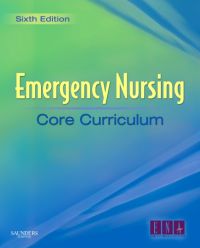Whether you are a new or an experienced emergency nurse, you'll find that the Emergency Nursing Core Curriculum, 6th Edition is an essential tool for your practice. Authored by the Emergency Nurses Association (ENA), this highly-respected resource will help you build and verify your knowledge, develop practice standards, improve quality of care, and educate nursing staff as well as patients and families. The Emergency Nursing Core Curriculum, 6th Edition is also the ideal resource to help you prepare for the Certification for Emergency Nurses (CEN) exam.
New to this edition
- The most recent CEN examination content is included to ensure that you're prepared and confident.
- Nine new chapters incorporate the latest information about:
- Triage
- Complementary and Alternative Therapies
- Cultural Dimensions and Emergency Nursing
- End-of-Life Issues in the Emergency Department
- Hemodynamic Monitoring
- Hematologic/Oncologic Emergencies
- Mechanism of Injury
- Weapons of Mass Destruction
- Forensic Nursing Practice
- A new unit on trauma emergencies reorganizes information from the previous edition to help you more easily find the facts you need.
- More illustrations and tables are included to enhance your understanding of key information.
Key Features
- Authored by ENA, you can rely on this text to be the most authoritative and up-to-date resource available.
- The text's outline format and alphabetical listing of the Clinical Emergencies chapters mean you can find the information you need - fast!
Author Information
By Emergency Nurses Association
Clinical Foundation1. Nursing Assessment and Resuscitation2. Triage3. Abuse and Neglect/Sexual Assault4. Complementary /Alternative Therapies5. Cultural Dimensions6. End-of-Life Issues in the Emergency Department7. Invasive Hemodynamic Monitoring8. Organ and Tissue Donation and Post-Transplantation Emergencies9. Pain Management Clinical Emergencies 10. Abdominal Emergencies11. Cardiovascular Emergencies12. Dental, Ear, Nose, and Throat Emergencies13. Endocrine Emergencies14. Environmental Emergencies15. Facial Emergencies16. Fluid and Electrolyte Abnormalities17. Genitourinary Emergencies18. Hematologic/Oncologic Emergencies19. Communicable and Infectious Disease Emergencies20. Medical Emergencies21. Neurologic Emergencies22. Obstetric and Gynecologic Emergencies23. Ocular Emergencies24. Orthopedic Emergencies25. Toxicologic Emergencies26. Psychiatric/Psychosocial Emergencies27. Respiratory Emergencies28. Shock Emergencies29. Wounds and Wound ManagementTrauma Emergencies30. Mechanism of Injury31. Nursing Assessment and Trauma Resuscitation32. Abdominal and Urologic Trauma33. Burn Trauma34. Neurologic Trauma35. Ocular and Maxillofacial Trauma36. Obstetric Trauma37. Orthopedic Trauma 38. Thoracic TraumaProfessional Components39. Disaster Preparedness and Response40. Weapons of Mass Destruction41. Education: Professional, Patient, and Community42. Emergency Patient Transfer and Transport43. Forensic Nursing Practice44. Legal and Regulatory Issues45. Professionalism and Leadership46. Research and Evidenced-Based PracticeAppendicesNANDA-Approved Nursing DiagnosesEvaluations and Outcomes Correlated with Current Nursing DiagnosesComa ScalesAge-Specific Vital SignsInfant Pain ScalesTrauma Score




